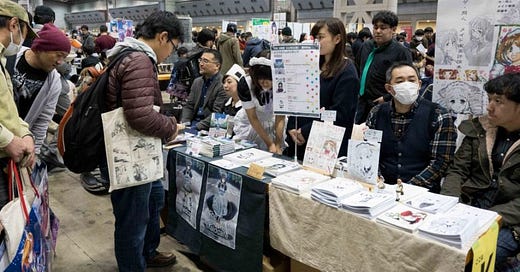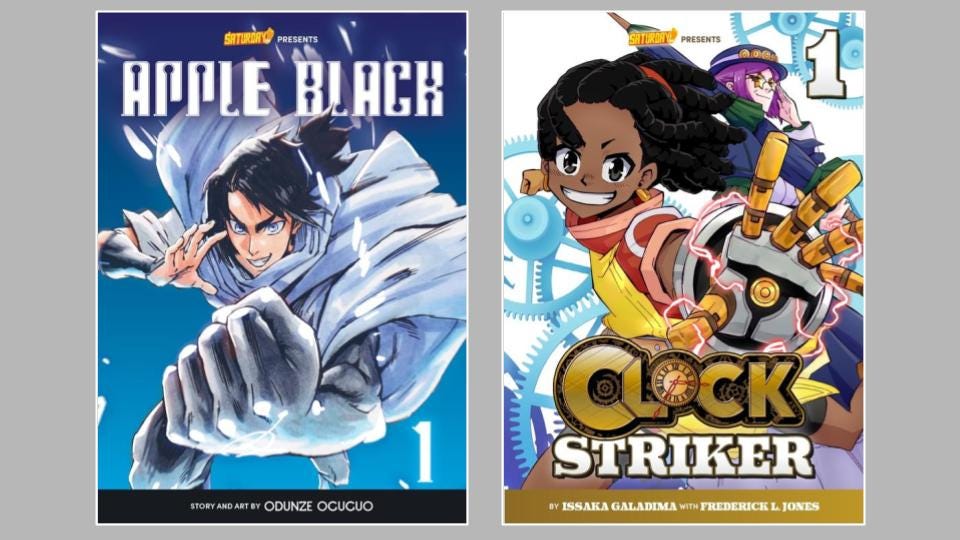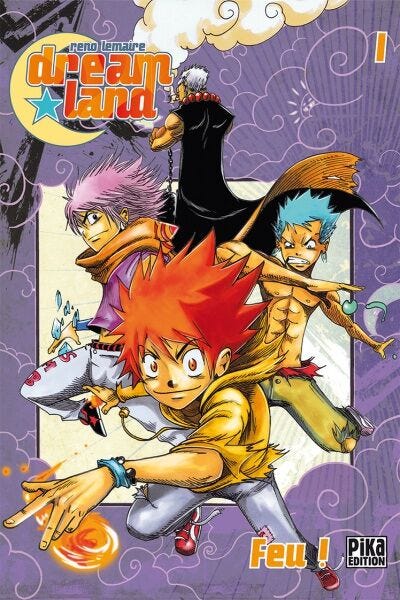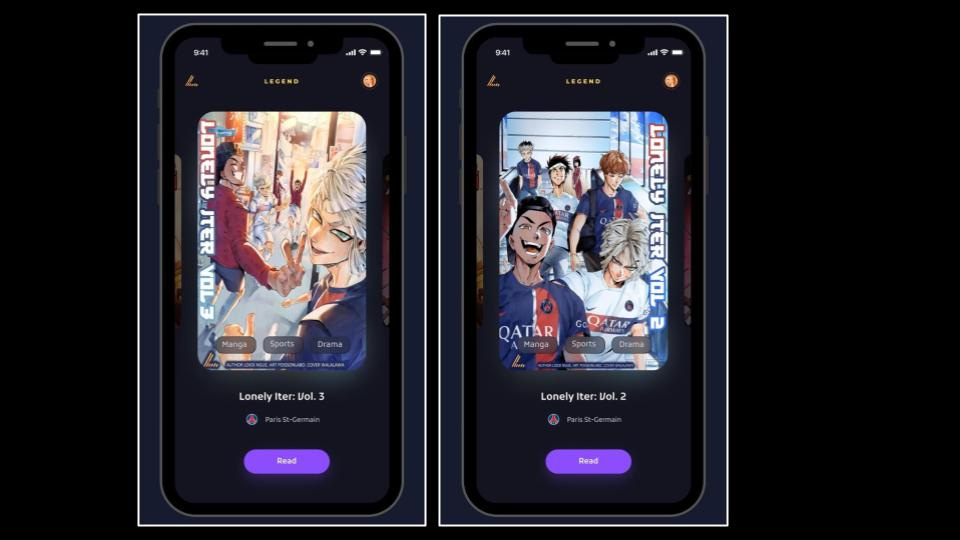Manga! Everyone is Doing it
There's a lot going on in the international manga scene. I am going to zoom in on why you should be paying more attention to what's going on outside of Japan
Recent data suggests that manga is still the dominant graphic storytelling medium in the United States following several years of unprecedented growth during the Pandemic. According to NPD BookScan1, in the first six weeks of 2023, manga comprised over 60% of the total comics and graphic novel market share in North America and a glance at the Top 20 Author Graphic Novels for March 2024 shows manga/manwha2 dominating. Manga is well and truly here to stay as the preferred graphic novel format of choice for teens and adults around the world.
If you work in anime like I do, you need to keep up to date on trends and events in the manga publishing industry because it is the content funnel that feeds it. Like anime, technology has completely transformed the distribution of the medium. Today, there is more manga in circulation globally than ever before, and while print manga volumes (“Tankōbon”) remain the most desirable part of the value chain to consumers and publishers alike, it’s the rise of digital publishing, e-commerce and streaming that has hyper-accelerated the growth and development of both the manga and anime industry.
Technology is fundamentally altering what manga is. Whether you like it or not, a revolution is underway. It has been for the the past decade, and it is going to accelerate over the next. It is a revolution that will be driven by the UGC economy and powered by apps.
Comiket, the annual doujinshi convention hosted at Tokyo’s Big Sight convention centre. It’s literally the world’s biggest “artists alley” © Reserved
The Sweet Otaku Life
Manga readers also watch anime and play video games. And they love to create! This is a normal and accepted aspect of “otaku culture” globally. Furthermore! There is a set pattern of behaviour that this audience adopts, which is identifiable and measurable.
The Japanese market research firm, Yano Research Institute published an interesting survey called Consumer Survey on “Otaku” in Japan: Key Research Findings 2023, which targets 10,000 Japanese men and women between the ages of 15-69 and amongst other things lists the top 30 most popular hobbies and past-times of otaku. Amongst other things, the survey reveals what are the most popular past-times by “target genre” such as “Anime”, “Manga” and “Cosplay” and measures each according to estimated number of otaku participating in these activities, annual spend and average number of hours per week occupied by this hobby. My take, from reading the survey results, is that manga readers are most likely to watch anime, read light novels and participate in doujinshi3 culture.
I want to focus in on doujinshi for a moment because I believe it explains the growth and popularity of international manga as well as other forms of participation amongst global fans of anime, manga and video games.
“International Manga" as defined by the Japanese Ministry of Foreign Affairs, encompasses a wide range of comics. It refers to all foreign comics which draw inspiration from the “form of presentation and expression” found in Japanese manga.
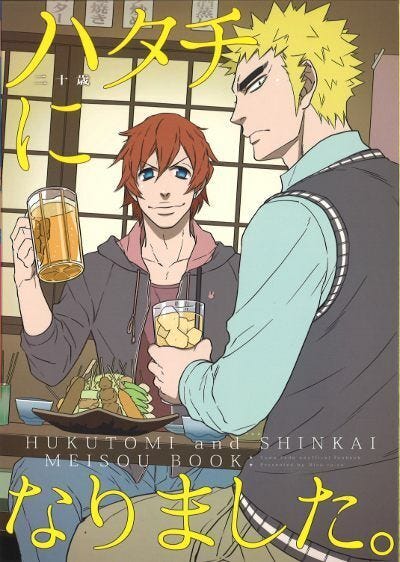

What is Doujinshi?
According to a recent survey of Japanese otaku, the local number of doujinshi hobbyists is more than 1.1M. Doujinshi is the fourth most popular past-time for otaku in terms of total hours per week spent on the hobby (3.6 hours). Watching anime and reading manga and light-novels are the top three most popular past-times (in that order).
Experts in doujinshi hypothesise that doujinshi’s shift in focus to manga probably occurred some time after the end of the second world war and the beginning of the first Manga Boom, which undoubtedly created fertile ground for fan-created content.
In fact, it was the early formation of Doujin Groups during this period that brought mangaka like Shotaro Ishinomori (Cyborg 009, Kamen Rider, Super Sentai) and Fujio Fujiko (Doraemon) to the attention of publishers and paved the way for the second major boom in manga publishing in the 1970s.
Doujinshi are today best known as self-made fan-fiction and fan-art fanzines, often based on the creator’s favourite manga characters and plot lines, and often utilising parody and humour. However! Doujinshi were initially original works, created to share with small communities of fellow writers and aficionados, bypassing the gate keeping of the established local publishing industry. The first magazine to publish doujinshi novels was Garakuta Bunko, founded in 1885 by writers Ozaki Koyo and Yamada Bimyo.
Manga in the Creator Economy Age
One could safely say that doujinshi is possibly the first and best example of the symbiotic relationship between creator, character and consumer. A positive feedback loop, which to me is an early example of UGC (“user generated content”) and the Creator Economy - the current buzz phrase across the media and entertainment industry.
There is no doubt that doujinshi fulfils some vital human needs amongst its participants, and that many of these are replicated across the otaku experience overall. Things like creative expression, community and connection, accessibility and affordability, the variety and uniqueness of the content on offer, and support for the creators are core principles that more or less drive the global manga and anime industry today.
Two of the central pillars of doujinshi culture are also central to the Creator Economy across games, anime and video are:
Creative Expression and Freedom - Doujinshi allows fans to engage with the stories and characters they love. They can create new adventures, explore relationships between characters and take a deeper dive into the story world. Don’t underestimate how important this also is to ROBLOX and Fortnite players. So! Why wouldn’t it also be important to young manga readers too?
Community and Connection - Doujinshi circles and conventions foster a strong sense of community among otaku. This sense of belonging is a powerful draw, best illustrated by Comiket (“Comic Market”), which is the largest fan-convention event in Japan, and possibly the world. It runs over four days and attracts more than 750,000 visitors. Anime Japan convention recently attracted over 170,000 visitors and Anime Expo in Los Angeles regularly attracts over 220,000 visitors during its 4-day run.
Saturday AM's "Clock Striker" by Isaka Galadima & Frederick L. Jones, and "Apple Black" by Odunze Oguguo
What is it about reading and enjoying manga that generates such a strong desire in many of us to want to create our own characters and stories?
I recently had the pleasure of meeting Frederick Jones, the founder and publisher of MyFutprint Entertainment, Llc - the digital publishing company that owns and operates Saturday AM, one of the most successful international manga brands currently operating in the United States over the past decade.
According to Frederick, Saturday AM’s insights and analytics suggests that as much as 80% of their readership want to create their own manga-inspired content. This should come as no surprise to anyone who is paying attention. Surprisingly! Outside of doujinshi circles and online groups, there is very little infrastructure outside of Japan for the publishing and distribution of original manga IP created by international mangaka.
Influential
Imprints like Saturday AM and Noir Caesar have bypassed the traditional publishing industry by launching as digital publishers first, before moving to print publishing and distribution with the likes of Tokyopop and Quatro. Saturday AM titles are currently available to read in the English language, in more than 40 countries worldwide. They have a focus on shonen style action-adventure storytelling that is rich in humour and suitable for ages 13 and older. In fact, one of their largest customers for print editions are American libraries.
Saturday AM offers a very diverse portfolio of titles and creators emanating from as far field as Nigeria, Brazil, Denmark, France and North America. These creators are also influencers in their own right. One of SaturdayAM’s biggest titles is Apple Black. Created by Odunze Oguguo, who goes by the name @whytmanga on Instagram where he has amassed over 136,000 followers. Oguguo is Nigerian, one of MyFutprint’s founders and he currently resides in North Texas
Clock Striker is co-created by Frederick L. Jones and Isaka Galadima who is based in France and originally from the Repbulic of Niger. Isaka runs the Insta account @gladiskstudio. Clock Striker is a YALSA award winner for 2024 and TLA4 nominated book of the year for teen readers. Another new title to launch on the label is Gunhild by Fred Tornager. A strange and moving fantasy series that combines Tornager’s personal experiences growing up in Denmark as an adopted child from Colombia with their love of Nordic folklore.
“DREAMLAND” by Reno Lemaire and published in France by Pika Editions
MyFutprint and Saturday AM shows what is possible in terms of story, character and audience for manga properties that are produced outside of Japan. Their success in the English-speaking independent comics scene and further afield, is replicated to even more impressive levels by the European manga publishing industry. French brands like Pika Edition, ANKAMA, Kana and TokyoPop in Germany have been developing and championing homegrown mangaka since the early 2000s. Titles worth your attention include Dreamland by Reno Lemaire, Radiant by Tony Valente, Wakfu by Tot & Cynthia Leman and Goldfisch by Nana Yaa.
LegendHQ - UGC and Voice
Not every otaku is a fledgling artist and writer, but that doesn’t mean they don’t want to make stuff. LegendHQ is another new player in the world of digital manga and comics publishing founded by CEO, writer and serial entrepreneur, Kyra Phalen.
What makes LegendHQ unique is that it is the only digital comics platform that provides an audio experience alongside words and artwork. The app provides character audio for a range of works including their collaboration with PSG (Paris Saint-Germain Football Club) in many different languages. You can download the app for free and I’ve got to say, it’s really good. The quality of the audio is excellent, the interface is simple and easy to use, and the image and audio presentation is seamless.
LONELY ITER tells the story of a young boy who has lost his passion for football. However, during a serendipitous encounter with the Paris Saint-Germain team on their pre-season tour of Japan in 2022, he re-discovers his love for the beautiful game. By Loick Ngue & Poissonlabo.
LegendHQ has interactive features that allow artists to communicate with their fans, but even more interestingly, it allows the fans to create and share their own voice-over recordings with their own social groups. IT is important to underline what a fantastic feature this is. Who hasn’t wondered what it would be like to do some anime voice over acting? This is the closest I’ve ever gotten to that experience and it was a lot of fun.
LegendHQ has an exclusive digital partnership in place with PSG. The current title is Lonely Iter, with another PSG title promised to drop this summer. The platform is promising more high profile sports and lifestyle partnerships soon to be announced, which further highlights the merging of professional sports, anime, videogames and manga fandom. LegendHQ’s partnership with PSG illustrates one way forward for international manga IP to connect in a meaningful way with large audiences who are familiar with manga as a storytelling medium, but not necessarily burdened by preconceived notions of provenance. This will be essential to the international growth of manga.
Did you know? A new report from Polygon suggests that anime is more widely viewed than the NFL by GenZ consumers. Polygon’s survey of 4,275 Americans aged 18+ found that 42% of respondents watch anime weekly, compared to only 25% who follow the NFL.
A sales tracking service now called “Circana”.
“Manwha” is used to describe Korean manga-style comics. The term is also used to describe Chinese manga too.
“Doujinshi” (同人誌, dōjinshi) is a Japanese term for self-published printed works, most commonly referring to manga, light novels and magazines.
WINNER of GREAT GRAPHIC NOVELS FOR TEENS 2024 — YALSA. Nomination for Texas Library Association 2024 Mavericks List

